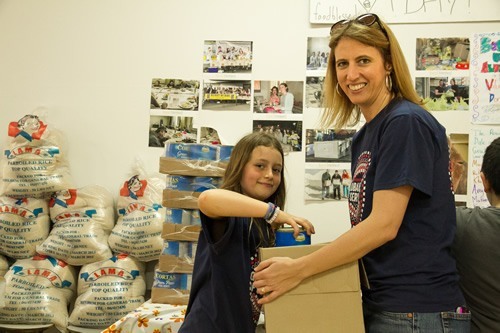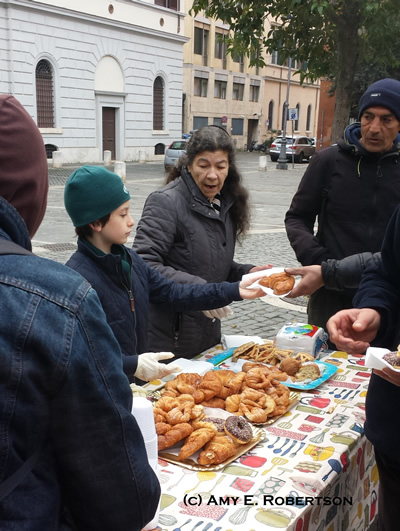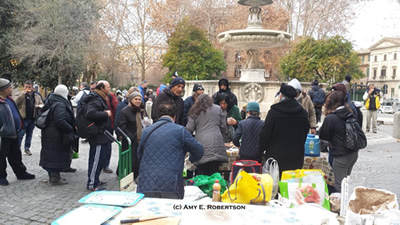Top Considerations for Volunteering Overseas… with Your Kids
Article and photos by Amy E. Robertson
 |
| Amy E. Robertson and her daughter in Beirut, packing food boxes for Syrian refugees and vulnerable Lebanese. © Ruth Moucharafieh |
When I think about my childhood memories, many of the ones that stand out are from family vacations.
Like many childhoods, mine was filled with homework and sports, household chores and hanging out with friends, games and squabbles with my sibling, family meals. Millions of mundane moments that make up a happy childhood, but blur in memory as time passes.
But I do have distinct memories (and a handful of blurry photos) from my first airplane ride and our family trip to Disneyland when I was seven. Our family took a few more “big trips” over the course of my school years: Yellowstone, Washington D.C., and Puerto Vallarta, Mexico. Some moments from those trips are immortalized in pictures and trip diaries. Many more stay in my mind because the experiences I had on those trips and the places I saw were so different from what I knew back home.
Given the outsized impact family vacations can have on children, it’s no wonder that more and more parents are considering adding in a volunteer experience.
Why Volunteer on Vacation Overseas?
Whether individually or as a family, volunteering overseas is a chance to see beyond typical tourist attractions, and to act as a global citizen in our increasingly interconnected world. We take our children on vacations to expose them to new things, and to show them that there is more to the world than shopping malls and video games. Volunteering as a family can be a way to also show them something more than beaches and nice hotels, and to demonstrate a commitment to participating as a member of our global community. And it usually means getting the chance to know people that you wouldn’t otherwise meet.
Resources for Independent, Low-Cost Volunteering
See Grassroots Volunteering and Volunteer South America for cheap options.
Book (print and e-book available): Volunteer Vacations in Latin America, which I wrote for Moon Handbooks. Here is just one example of the kind of opportunities listed in the guide:
With two locations in Panama, the Spanish language school Habla Ya organizes volunteering placements in community recycling, sea turtle protection, elder care, mobile health clinics and local daycares. The placement fee is just US$75, plus a daily fee of US$5 for students (US$15 for those not taking Spanish lessons). In addition, the volunteering fee is waived for kids who volunteer with their parents. |
Key Considerations
Pitfalls — While volunteering overseas can be an incredible experience, not all opportunities were created equal. Avoid the pitfalls of volunteering by doing your research and asking good questions before signing up. Teach your child to be a better traveler and volunteer by making him or her (or them) part of that process.
Time Commitment — Volunteering can make up the bulk of a vacation or be just one small part of it, it’s up to you. Depending on the type of work and the organization, a month’s worth of six-hour days may be requested, or a visit for an afternoon may be enough. What matters is that the volunteer opportunity is part of a well thought-out, long-term program.
Type of Work — Broad categories include agriculture, children/youth, community development, education, environment, health, wildlife protection and women’s empowerment. (For a better understanding of each, see the explanations in this article on Types of Volunteering.) Kids are often drawn to opportunities that involve animals or other kids, and agricultural/environmental work can also be particularly suitable to kids that love the outdoors.
Price — There are some expensive voluntourism programs out there, and when you multiply them by the number of family members you have, they can quickly become out of reach. One low-cost option is to connect directly with the non-profit that you’d be interested in supporting rather than go through a volunteer placement agency. Many of these options are also community-led, better ensuring the relevance and usefulness of the volunteer work. However, more expensive programs often offer additional services such as accommodation, meals, language courses and more.
Suitability for Kids — This is a two-pronged consideration. First, has the organization utilized kid volunteers before? If the organization seems reluctant about kid volunteers, then take your cue and find a different opportunity. My own book, Volunteer Vacations in Latin America, includes nearly 60 organizations which specifically welcome families as volunteers. And there are many more options if your children are older teens (age 15+). Keep looking until you find someone welcoming.
Second, is your kid ready for this? The answer, of course, depends on your child’s personality and on how you are raising your child. Travel exposes our children to new things, but volunteering means exposing them to things that may not be easy. But especially when traveling in developing countries, having the chance to go beyond tourist sights and fancy hotels in order to stand in solidarity with the people and environment of the destination can be enriching for all ages.
Are you and your kids ready?
A Gift of a Couple of Hours
 |
| The author's son helps hand out croissants and coffee to the hungry and homeless in Rome, Italy. © Amy E. Robertson. |
Whether you have a fairly full vacation agenda or younger kids who would get the most out of a shorter commitment, there are a surprising number of ways to make a contribution in anything from a couple of hours to a couple of days.
In my family, supporting soup kitchens is a multigenerational affair. When visiting my parents in Seattle, my kids butter bread, chop veggies for salads and organize the desserts while my parents and I help prepare the main meal. We’ve noticed that the clients save their warmest smiles and greetings for the kids, and suddenly the homeless guys that were lurking outside on the street don’t seem so scary any more.
I also regularly visit Rome, Italy, to see my husband’s side of the family, and recently discovered that there is a website, Romaltruista, that connects volunteers with opportunities. Through it, my son and I ended up spending a morning in a piazza of Rome serving breakfast to the homeless. An internet search of your next travel destination may turn up a similar volunteer resource.
| |
 |
| Helping to feed hungry and homeless in Rome, Italy. © Amy E. Robertson. |
Besides soup kitchens, other possible short-term opportunities include one-night vigils of turtle hatchlings as they trek to the sea, hosting a crafts/music/sports workshop at a local school, daycare or afterschool program. Look for opportunities that are part of ongoing volunteer programs, so that your single afternoon of volunteering is actually worthwhile. |

|
Amy E. Robertson has written many articles for TransitionsAbroad.com as Connected Traveler Contributing Editor.
She is the author of numerous publications for Moon Handbooks. Her writing has been published on NPR, Vice MUNCHIES, Budget Travel, Delta Sky, National Geographic Traveler, Wall Street Journal, Christian Science Monitor and Travel + Leisure, among others.
Amy has lived in six countries and traveled in more than 60.
Her volunteer experiences include building houses in Washington State and Honduras, monitoring presidential elections in Ecuador, working with youth on social documentaries in Bolivia, and serving lunch at soup kitchens in Seattle and Beirut.
Amy has a background in international development and nonprofit management and has worked in both the private and nonprofit sectors.
|
|
